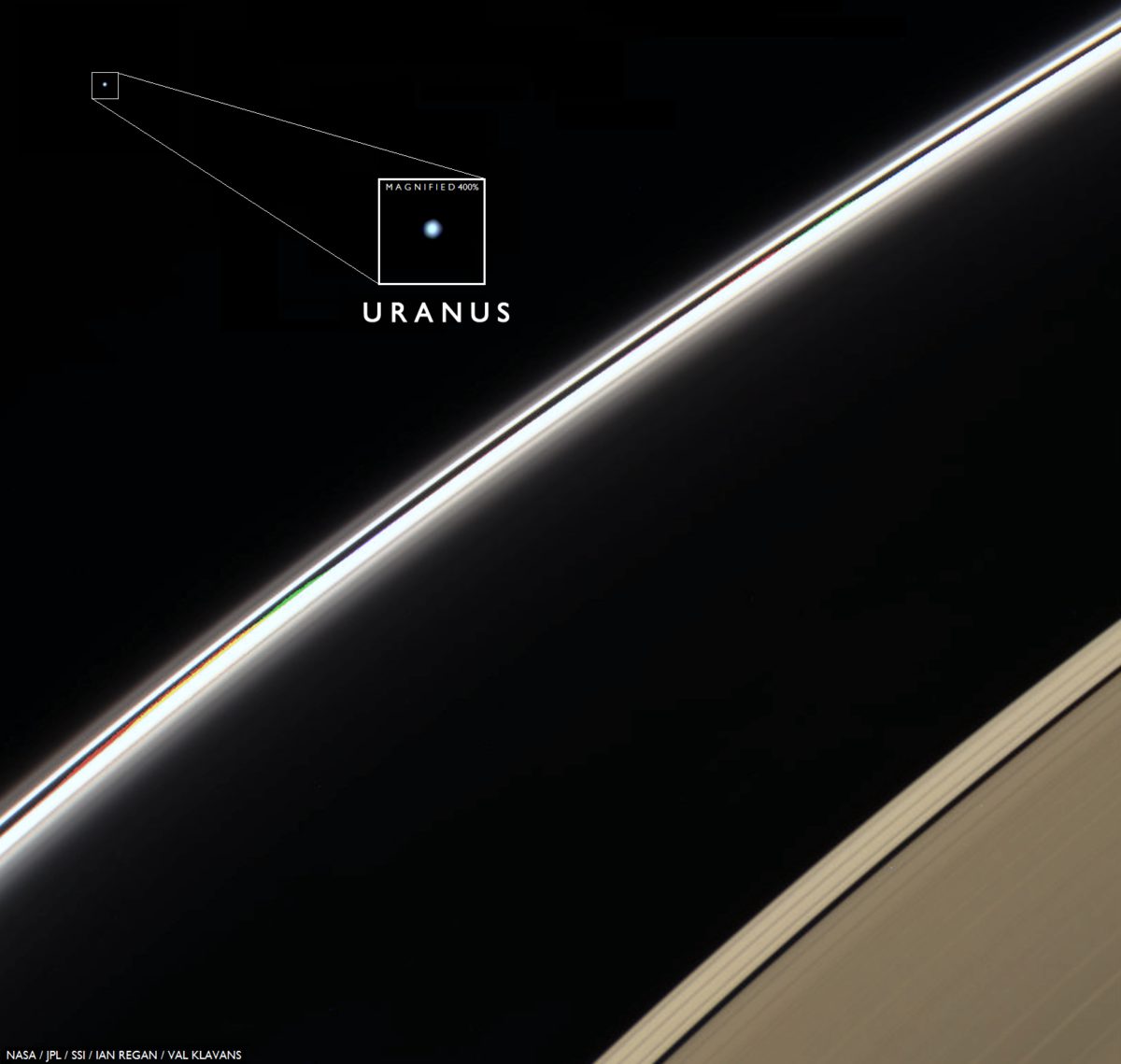Val Klavans • Apr 30, 2014
Another Pale Blue Dot — Uranus Spied By Cassini
When Voyager 1 took the first mosaic of the solar system from beyond the orbit of Pluto in 1990, it provided the inspiration for Carl Sagan’s famous ‘Pale Blue Dot’ quote. Ever since, robotic ambassadors from Earth have captured many similar ‘Kodak moments,’ where far-off and distant celestial denizens have been captured alongside, or in lieu of, the ostensible ‘prime’ planetary target.
The Cassini mission has already returned an array of images of other solar system members from Saturn orbit: Earth (and the Moon), Venus, Mars, and Jupiter. It’s time to add another world to that list! On April 11, 2014, as Cassini was mid-way through its two-hundred and third revolution of the ringed giant, it took advantage of a propitious alignment as a distant Uranus zipped by Saturn’s F-ring.

The geometry of this observation is shown below. As seen from Cassini, Uranus was, in effect, at ‘superior conjunction’, on the other side of the Sun, a mere 4.28 billion kilometers distant (compared to Saturn, just a stone’s throw of a million kilometers away from the camera).


The data set collected by Cassini on April 11, and transmitted back to Earth that same day, included three wide-angle camera frames, taken through red, green, and blue filters, and nine narrow-angle camera frames, also through red, green, and blue filters, with a range of exposure times. After the data were transmitted back to Earth by Cassini, via the Deep Space network, it lay dormant in the raw images page, waiting to be shown to the world. One of us (Val) knew to be on the lookout for this photo after reading the latest ‘Looking Ahead’ article on the CICLOPS website. While Val processed the wide-angle view (which lacks the spatial resolution to register the faint image of Uranus), Ian tackled the narrow-angle frames. These figures show the three resultant composites; the color balance has been adjusted to natural color as might be perceived by a hypothetical astronaut riding onboard Cassini:
The narrow-angle frames proved difficult to work with because of the changing geometry of Saturn’s rings during the observation period. The solution was to produce three separate composites using the longer-shuttered frames: one aligned with Uranus, one aligned on the F-ring, and one aligned on the edge of the A-ring. These three images were selectively merged to produce the final composite. We decided that images with the longest exposure times were more suitable for this procedure, since the faint Uranus stands out to maximum effect, albeit to the detriment of the obviously overexposed F-ring, which is naturally brighter than the A-ring in forward-scattered light.
But the alternate composite, consisting of short exposures shuttered to favor the F-ring and not Uranus has its interesting features too. Its spindly ring contains pastel rainbow colors, possibly caused by clumps and wrinkles that moved between the constituent red-, green-, and blue-filtered frames.
Val also added an inset of a magnified version of the Uranian disc, to help emphasize the ice giant’s distinctive pale blue hue. She posted the final product to the Facebook and Twitter identities she maintains in the persona of "Titan Saturn's Moon" to an abundance of ‘likes’ and ‘retweets’, showing that these photo opportunities, while not necessarily useful for science, provide rich rewards to the tax-paying public for their investment in robotic emissaries such as Cassini.
One popular science page on Facebook reposted the composite, resulting an in avalanche of ‘likes’ and, perhaps not unsurprisingly, an equal quantity of Uranus-based jokes; such is the burden that planetary scientists must bear when discussing the much-mocked seventh planet.
Support our core enterprises
Your support powers our mission to explore worlds, find life, and defend Earth. You make all the difference when you make a gift. Give today!
Donate

 Explore Worlds
Explore Worlds Find Life
Find Life Defend Earth
Defend Earth




